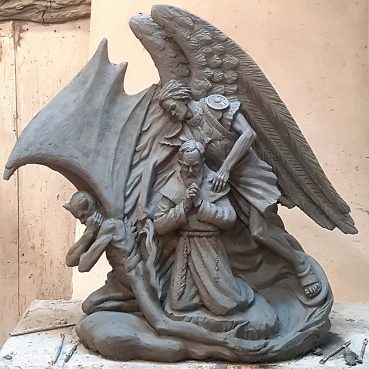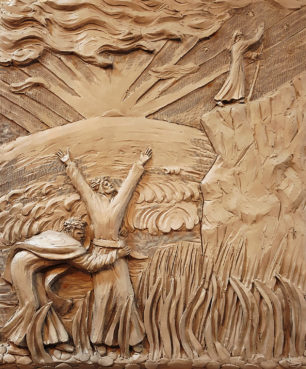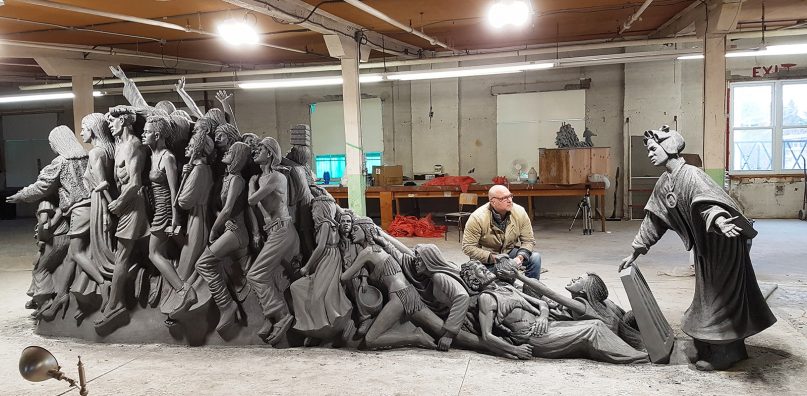VATICAN CITY (RNS) — A Catholic sculptor wants to keep the church relevant with his art, but as mounting secularism and the COVID-19 pandemic challenge the institution, the artist claims the devil is in the details.
“Today we want to pretend that evil doesn’t exist,” said Canadian artist Timothy Schmalz, but Christianity, and Catholicism in particular, “has not only accepted the idea that evil is within our society but has represented it and given it artistic form.”
Schmalz’s latest work represents the mystic Capuchin Padre Pio — a 19th-century friar known for receiving the stigmata, the wounds that Christ suffered during his crucifixion — caught in the struggle between the archangel Michael and the devil.
The art piece, which will be cast in bronze, will be installed in St. Michael’s Cave in southern Italy, which Padre Pio visited in 1917 and where he claimed to have gained insight on his evangelizing mission. The friar was recognized as a saint by Pope John Paul II in 2002.

Canadian artist Timothy Schmalz’s recent artwork depicting Padre Pio between the archangel Michael and the devil. Photo courtesy of Timothy Schmalz
The motivation for this artwork, the artist told Religion News Service on Wednesday (June 16), is his belief that “we need to understand today there is evil out there and if a saint could be wrestling and fighting demons then it’s something we all can experience.”
RELATED: Bishops quick to debate Eucharist — and Joe Biden — at meeting
Schmalz spent the last two years toiling in his studio, working on numerous projects to be presented all over the world, from Canada to the United Kingdom to the Vatican. He has a special devotion to Padre Pio and created four art pieces representing the saint.
Just like Padre Pio, he said, the Catholic Church is currently embattled in a fight against evil in today’s society, following the sexual and financial scandals that have challenged its global credibility. Schmalz hopes that through art, the Catholic message can find new ways to communicate and relate to the faithful today.
“During this pandemic, churches have been closed for people,” he said, “but they’ve been closed way before the pandemic.” According to the artist, COVID-19 has accelerated the emptying of the pews as attending Mass became impossible for many months.
“We need to reel them back in,” Schmalz said, adding that his sculptures, which are often exhibited outside and in public places, allow people to “encounter it without the intimidation of going into a church and joining into a community.”

Purgatory, Canto 1. Work by and images courtesy of Canadian sculptor Timothy Schmalz
In the past, art has been a favored method of evangelization in the Catholic Church: from Giotto depicting the stories of Christ’s life as Franciscan friars preached the gospel out in the streets, to the counter-Reform efforts to simplify art and breathe new life into the works of Caravaggio and Bernini. Oftentimes, art came to the rescue when Catholicism was threatened from the outside — and more often from within.
Schmalz has accepted the challenge of restoring the Catholic Church’s credibility in today’s modern context. His work depicting Padre Pio is not the first time he addressed the question of evil in his work, having spent the better part of the year in the herculean effort of translating into sculptures all 300 cantos of the “Divine Comedy” by the Italian poet Dante Alighieri on the 700th anniversary of his death.
The bronze cast panels, representing the poet’s imaginary journey from hell to purgatory and finally heaven, will be part of an open-air installation in Schmalz’s native country this year. But evil is not only to be found in hell, according to the artist, who has made a name for himself by representing evils that afflict society today.
His work “Angels Unawares,” showing the plight of immigrants and refugees through history, became the first art piece to be placed in St. Peter’s Square since the artist Bernini completed the square in 1667. Last year the undersecretary of the Vatican Commission for Migrants and Refugees, Cardinal Michael Czerny — who reports directly to Pope Francis — commissioned Schmalz to create another statue on human trafficking.
Pope Francis has often drawn attention to the suffering caused by human trafficking, which affects over 25 million people globally. Schmalz’s statue, which will be installed at the Vatican, is over 20 feet wide and shows St. Josephine Bakhita, who found her faith after being trafficked, opening a hatch to release numerous figures fleeing this form of modern slavery.
Schmalz said that when Czerny commissioned the piece, he highlighted the connection of immigration to human trafficking. The cardinal said “if we don’t take care of the people in your one sculpture, Tim, they will end up in your other one,” the artist recalled.
A second cast of the large sculpture will be installed in Washington, D.C.
In fighting the evils challenging the Catholic Church and the world today, the sculptor said, awareness is key. “Human trafficking is kept underground, and as long as it’s kept underground it will always exist,” he said.
RELATED: Baptist and Catholic leaders grapple with similar problems in different ways





